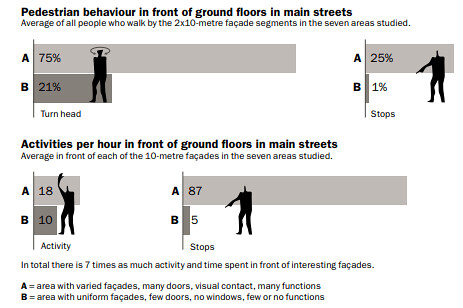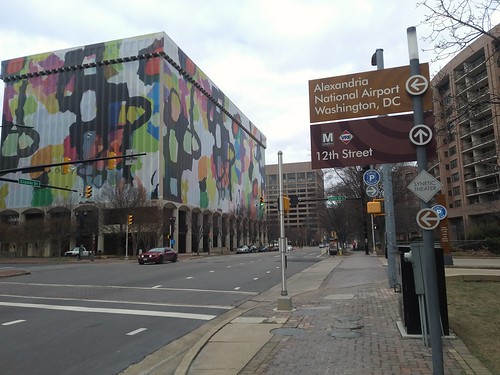The car versus the pedestrian in (sub)urban design and placemaking

"Pedestrian behavior in front of ground floors on Main Streets," from "Close Encounters with Buildings."
A point I should have emphasized more in the previous entry is that while it is true that the basics of intensification, urban design, and placemaking are the same whether or not you're working in the city or suburbs, the fact is that designing land uses in the context of automobility is different and does constrain your ability to do "great things" in the suburbs.
I've mentioned from time to time that I was at a conference in 2013 and after a presentation by a guy from Australia specializing in "night markets" as an activation device, a real estate guy (from one of the nation's biggest firms) came up to him talking about how he could do this at a suburban mall location in North Montgomery County, which his company was managing because it was in foreclosure. I happened to be there and figured out what property he was talking about and exclaimed "just tear the mall down." (It was Lake Forest Mall in Gaithersburg.)
 They didn't tear down Lake Forest Mall and it's been through at least one more foreclosure since, but the basic point I was trying to make is that it's hard to activate a place that everyone drives to.
They didn't tear down Lake Forest Mall and it's been through at least one more foreclosure since, but the basic point I was trying to make is that it's hard to activate a place that everyone drives to.Although again, the way that suburban business districts like Crystal City have been working to activate what would be very drab places without the addition of a big dose of creativity ("'Crystal City is so cool': Maybe, but it's not quite D.C.," Washington Post; "JBG Smith wraps Crystal City buildings," Washington Business Journal ) proves that creativity and innovation is not exclusively a center city phenomenon. Compared to Lake Forest Mall--20+ miles from Downtown DC--Crystal City is helped by a closer-in location, just across the river from the center city.
Outside of suburban urbanism in towns and town centers like Alexandria and Arlington, you can and do have many little oases of "new(er)" "urbanism", such as in the DC area: Reston Town Center ("Silver line reshaping commercial office market in Fairfax County," 2015) and Bethesda Row ("Why are people so damn good at asking the wrong questions," 2006) which were some of the earliest examples of this; Shirlington; the Mosaic district in Merrifield; the developing Pike and Rose district on Rockville Pike as the augur of change in the redevelopment of the White Flint district, which had been anchored by a shopping mall; the fact of the matter is that in the suburban context, because you're designing around the car, it's still about superblocks and big spaces.
You can do placemaking in the oases, but people have to drive to those oases, and the distances between places make it difficult to build "Walkable Communities" where the sustainability expands outward beyond the small confines of the oasis.
-- "How can I find and help build a Walkable Community?," Dan Burden and Walkable Communities
It's also hard to get the residents to think "urbanistically," such as paying for parking as a way to manage the resource ("Reston Town Center parking issue as a "planning failure" by the private sector," 2017).
The Silver Line Metrorail addition in Fairfax and Loudoun Counties in Virginia is a good example of this.
You can bring heavy rail service to the distant suburbs, but the distance between stations--about five miles--makes it very difficult to have the kind of intensification you get over the same distance in a city like DC where in a five mile distance you don't have two Metrorail stations, but six--at least in the core.
 A good resource for thinking about developing places at the scale of the pedestrian is the work of Jan Gehl, in books like Cities for People and Life Between Buildings and this paper, "Close Encounters with Buildings," later published in Urban Design International.
A good resource for thinking about developing places at the scale of the pedestrian is the work of Jan Gehl, in books like Cities for People and Life Between Buildings and this paper, "Close Encounters with Buildings," later published in Urban Design International.Many years ago the Downtown DC Business Improvement District published a brochure listing the "Principles of Great Streets" and the "Principles of Great Storefronts."
Don't know where my copy is of that brochure, but some time ago I scanned the most important passages and put them in Flickr.
This doesn't get at the issue of cosmopolitanism either or the idea that "city air is free air."
For a variety of reasons, the people who live in cities tend to be more progressive, more interested in innovation, etc., although that is definitely a generalization that does not hold true in many contexts.
Labels: cultural planning, suburban revitalization, urban design/placemaking, urban revitalization



1 Comments:
More on Crystal City:
https://www.bizjournals.com/washington/news/2018/10/24/crystal-city-emerges-as-jbg-smiths-test-lab.html
Post a Comment
<< Home